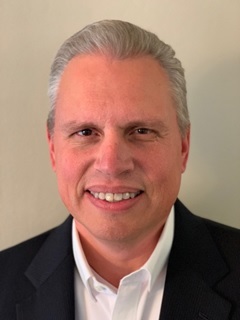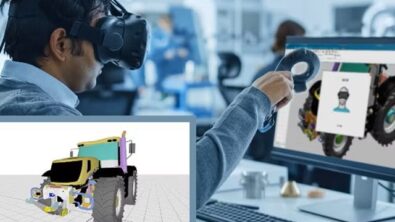Additive Manufacturing in the Aerospace Industry – ep. 1 Transcript


Welcome to the first podcast episode of the additive manufacturing and aerospace series, where we learn from experts about additive technology, or 3d printing, and the role software plays in this process. Our focus in this episode is the challenges to industry-wide adoption of additive manufacturing in the future, and specifically, its impact on aerospace technology.
The moderator of this discussion is Ashley Eckhoff, Marketing Manager for Siemens Manufacturing Engineering group, interviewing Dale Tutt, Vice President of Aerospace and Defense Industry at Siemens Digital Industries Software. Dale provides his expertise to the needs and perspective of customers by assisting our product teams in developing innovative solutions that improve the overall experience. Listen to the first podcast or read the transcript below.
Read the transcript

Ashley Eckhoff: Hi everyone, and welcome back to the Siemens Additive Manufacturing podcast. My name is Ashley Eckhoff and I work for the additive manufacturing program at Siemens Industry Software. We took a little break, but we’re back in action with a whole new season of discussions with various experts in the additive manufacturing space sponsored by the Thought Leadership team here at Siemens.
This season we’re going to shift the format just a bit and I’d like to walk down a few industry paths so that we can all understand how additive manufacturing is impacting various industries. We will have a mix of Siemens experts as usual, but we will also be including some industry experts and other voices as we discuss topics relating to additive manufacturing.
Today, however, I have the pleasure of sitting down with Dale Tutt. I’ll let Dale introduce himself, but Dale works on our industry team and we are going to take a couple of episodes here to talk with Dale about additive manufacturing in the Aerospace and Defense industry.
Dale, thanks for taking the time to talk with us today about how Additive is impacting the aerospace industry. But before we dive into our discussion, maybe you wouldn’t mind introducing yourself to our listeners, maybe a brief description of your background and what you do here at Siemens.
Dale Tutt: Hi, Ashley, and really thank you for having me here today, and I’m looking forward to the discussion. At Siemens, I am the Vice President of the Aerospace and Defense Industry. I lead the industry strategy. I often tell people that I represent the voice of the customer, because in my previous roles, I was the Vice President of Engineering and then Program Management at the Spaceship Company, which is part of Virgin Galactic doing commercial space tourism for Richard Branson, and we’re building spaceships to go into space. Before that, I worked at Cessna Aircraft Company or Textron Aviation for quite a few years in a number of engineering and program management leadership roles. Before I left Cessna, I was the Chief Engineer and Program Director for the Textron AirLand Scorpion jet, where we developed a new aircraft in about 23 months. But I was also the Director of Engineering for all of their Textron Aviation defense products. So, I’ve had a number of roles, leading programs, working with engineering teams, and developing new products throughout my career. And I bring that experience to Siemens as I work within our product teams to develop solutions for our customers, as well as our overall industry strategy.
Ashley Eckhoff: That’s awesome. I guess I didn’t know you were a Virgin Galactic. I think they were one of the very first customers I visited to talk about AM way back in the day.
Dale Tutt: Absolutely. I know that they were doing some work with engines. The Rocket Motors is now Virgin Orbit, developing their engine nozzles. So, it’s pretty cool stuff.
Ashley Eckhoff: I think I went to Death Valley, that was the first time I’d ever been there. So, that was really interesting. It was hotter than blazes, it was February or something. We’ve talked in previous episodes of this podcast about different use-cases for Additive Manufacturing, I guess we can probably start there. What use-cases do you see being used in the aerospace industry? I assume that light weighing would be one of those, but I assume there are probably others?
Dale Tutt: Obviously, I think, light-weighting is one of the more obvious examples that people think about, getting much more efficient use of the material. We see parts where the weights are being reduced to 10, 15, sometimes 20%, just because you’re only putting the material exactly where it needs to be, you’re not limited by machine constraints, say, a five-axis mill or by other tooling constraints. So, certainly a huge advantage there. I think the ability to get maybe more exotic shapes that are not limited by current tooling or machine constraints, for example, specialized ducting; in my past lives, we used Additive Manufacturing for plastic parts, but we were making specialized little ducts that would fit up inside the cockpit next to the windshield. So, we were able to produce parts that we couldn’t produce otherwise with traditional tooling. An interesting example that I think we’re going to see a lot more of is with developing prototype parts. For example, when I was working on the Scorpion jet, we weren’t sure on the shape of the nose on the inlet. And we were looking at what it would take to make this part and to make the tooling for doing this deep-drawn forming exercise to make it out of aluminum – it’s going to be like $1.3 million. And we knew that that was likely going to change as we went through the design and flight test process. So, we ended up making it using other methods and it took me like 10 weeks where we could have printed that in probably just a few weeks if we’d had Additive Manufacturing available to us. So, those are some examples where we see it – certainly, in manufacturing, just making parts, there’s a lot of parts that would be easier to make than machining them. You hear about few companies that are building some pretty large titanium frames in 100 hours instead of 100 days, and repairing parts, when you’re out in the field, to be able to print them, certainly using them for molds and tooling. So, you can make molds, shapes for pressing parts or for composite parts. So, there’s a lot of possibilities, especially I wonder if there are not opportunities as we get into more specialized materials in the future as well, to be able to print those instead of machining them because sometimes those specialized materials become a little bit harder to machine. So, definitely a lot of uses and a lot of applications for the aerospace and defense industry.
Ashley Eckhoff: I think occasionally when we run into customers in the aerospace industry, you’ve heard about some of those things as well, that jives with what I’ve heard as well. One of the aerospace industries, we’ve had lots of discussions with their people in the space-oriented part of aerospace, and I’ve heard that it can cost upwards of $10,000 for each pound of weight that you fire into space. So, we talked briefly about light weighing, and that’s something that’s really important to them but is saving weight something that is of similar importance to people in the commercial and military side of aerospace, does it get them the same kinds of return on investment just to make things lighter?
Dale Tutt: Absolutely. I’m actually kind of surprised sometimes that the numbers are not a little bit higher than $10,000 per pound. I know that many years ago when we were designing rockets and designing airplanes, we would sometimes throw out around the number of $5,000 a pound, $10,000 a pound. So, it certainly is that there’s a lot of value on a pound of weight. If you’re talking about space applications, weight is super-critical, especially if you’re talking about satellite in the upper stages because every pound you save is a pound of propellant that you can’t have to keep the satellite up in space longer or just a pound of capability. But with commercial and military aviation, it’s the same thing. You think about one of the stories that came out probably 10 or 12 years ago, and they were talking about the F-35 where they went through a big weight reduction program. The airplane had gotten a little bit heavy as it went through the design process, and they spent a fair amount of time to go back and really whittle away at the weight. That happens on a lot of programs, there are a lot of programs that I’ve been part of, and we start talking about every pound that you have on the airplane that’s above the target weight is a pound that can’t become payload. So, if you plan for the airplane to weigh 20,000 pounds, and it weighs 21,000 pounds, that’s 1,000 pounds less payload that you can carry. So, it’s very important, very critical. Even then, we still throw out sometimes $5,000 a pound, $10,000 a pound; it, oftentimes, will depend on where it’s at. If you’re having a center of gravity problem, say, you’re getting a little bit tail heavy, which happens on a lot of programs, you might be willing to pay $10,000 or $20,000 a pound to get the weight out of the tail than you would if it’s the weight that’s up in the front of the airplane. It’s kind of dependent. But the bottom line is weight is super-important, super-critical, and companies are willing to pay a bit of a premium to make sure that they can accurately manage your weight.
Ashley Eckhoff: I think I saw early on and when Additive became a big thing that there were several, I guess, research parts that people like Airbus and Boeing were working on for commercial airlines where they were printing things like seatbelt brackets, and I just saw one that was as large as a bulkhead. They were using things like topology optimization to try and reduce weight. Now, I don’t know that I’ve seen any of those become real. But interestingly, I think it’s something that even in the commercial area that they seem to be taking to heart.
Dale Tutt: The ability, especially when you have these large bulkheads, the machining tolerances can really add up on some of these parts. So, if you have a lot of the thickness of the part on the order of, say, 60,000 or 70,000 tons of big bulkhead or the web, if you’re just 10,000s thick, that can add 20 pounds on some of these large parts. So, whether you’re commercial aerospace or defense, everyone’s worried about weight and where the material is going, and how they’re going to manage it.
Ashley Eckhoff: Moving on a little bit, we’ve seen companies like GE, who, of course, make aircraft engines; they’ve adopted Additive in a real wholesale way by purchasing an AM hardware manufacturer. It seems that they were a pretty large investor early in AM’s maturation cycle. In general, how quickly does the aerospace industry adopt new technologies, and has the adoption of Additive been faster, slower, or about on par with what you’ve seen with other technologies in the past?
Dale Tutt: I think that it’s being a little bit faster than maybe some of the other technologies in the past. In large part, maybe, that’s because they’ve been able to learn from the lessons of some of the past experiences, and so thinking about composites technology when companies really started applying carbon-fiber technology and doing the composite layups. If you go back to, say, the 1970s, 1980s, there was fairly slow adoption, whether you were working with the FAA or the DoD agencies, there would be knocked down factors. So, you had to add some weight, and because it was a new process and a less understood process than metallic manufacturing, the adoption was slow and the regulatory authorities would be a little bit slow to adopt that as well. And then you started to see it being applied to a lot of secondary structures first. So, these would be applied to these structures that maybe weren’t quite as flight-critical, and if you had damage to the part during a flight that it wouldn’t be a critical failure or a catastrophic failure. But now here we are in the 2,000s, we have very widespread adoption. So, there are new tools for analysis, process simulation, and just the process controls that we have; learning those lessons from how some of the previous technologies have gone, it’s going faster, and I think the adoption is going to be a lot faster.
Ashley Eckhoff: We just talked about the different types of parts that might be printed. I assume the certification process or once you have to go through for different parts are probably different. So, a non-critical part, like you say, maybe a little door latch or something, it might have less stringent certification requirements than, say, a part that’s used in the engine or control systems of the aircraft. I assume that’s correct from what you said there?
Dale Tutt: Absolutely. For example, oftentimes will depend on the criticality of the loss of the part. So, if you have a little fairing, or a little door latch, or sometimes even secondary flight control surface – roll spoilers, we used to consider them secondary because if you had damaged the part and you lost the function, you wouldn’t necessarily have a critical loss of the aircraft, it would require maintenance when you landed but you wouldn’t necessarily have a flight emergency. But then when you start thinking about primary structures like wing spars, or an aileron, or an elevator surface, that is the primary flight control surfaces. It’s not necessarily that there’s a higher standard applied to them but the loss of the part has a higher effect on the airplane; that’s maybe why it gets a little bit different visibility. You don’t want anything to break on the airplane but if you do have damage, for example, you have a crack in the part or something, it’s easily inspected or the failure of it is not flight critical. That’s usually when it drives different certification requirements in different standards, so it’s a little easier to adopt for new technologies for those parts. And they do sometimes go through different levels of testing and qualification as a result as well. Obviously, a primary structure like a wingspan, you’re going to test it a lot because you want to make sure that it’s good. But if it’s just a little fairing covering up an antenna, it’s not flight-critical, so it may just go through a cursory testing or maybe even just an analysis.
Ashley Eckhoff: What is the normal process for adopting a new technology like Additive or a new part that’s printed with a new technology? Like we’ve mentioned here, it takes regulatory agencies, and certifications, and things like that, can you walk us maybe through the process?
Dale Tutt: There’ll be several factors that are involved. Oftentimes, you’ll see some industry groups that will help develop some of the processes, and they may even develop standards for testing. So, if you look at, again, using an example of the carbon fiber composites, when they were adopted, as they’ve been more widely accepted in the industry. You have industry standards bodies that helped develop allowables for the material, they also helped develop the processes that you can go through to certify new material systems. And oftentimes, the regulatory agencies like the FAA or IASA are part of that. So, they will go through, for example, a building block process. So, you may do testing on small coupon samples, and then you may build components or test components that are representative of the type of structures that you would have on an airplane, and then they test those,and then you bring structures together and look at how an assembly reacts. As you go through this process, you’re building up allowables throughout the entire process, and you’re validating your design methodologies as well as your manufacturing methodology. So, you’ll see these industry groups that help collaborate on developing new standards, new processes for new material systems. And then the regulatory agencies, they do participate in those but then they also set the rulemaking, the guidance, oftentimes, working with industries to help establish the actual regulatory or the certification requirements for those materials systems. So, they might issue it if it’s an especially new technology, they might issue special conditions. Eventually, they might make their way into normal rulemaking procedures. But as you go through these certifications, you have the rules from the FAA, you have the industry standards. And then you go through these different levels of testing at the component level, you have analysis methods that you have to validate. So, all of those come together, and then you submit that data package to the FAA. And even with the composite technologies, it’s often on a per aircraft or per program basis because people are often adopting new material systems. Even today, even though carbon fibers have been around for a long time, there’s often some new resin systems being developed that are a little tougher, they meet different requirements. So, it’s a process that everybody goes through today. I think as companies and the industry gets used to it, it’s a rigorous process but it’s fairly a well-understood process now, so companies know how to plan for it and work their way through the process.
Ashley Eckhoff: I assume that the standards bodies and maybe even the regulatory agencies are maybe a little different for space, defense, and commercial, or are they all the same?
Dale Tutt: Oftentimes, my experience has been that they will be a little bit industry agnostic, as they develop materials. Now, their adoption or their acceptance, they may have to develop specific standards for, say, the space industry, because there may be different regulations. So, the standard bodies kind of do the same work but they maybe have different nuances to some of the regulations that they have to show requirements for. It’s kind of the same standard bodies, oftentimes, they’ll use the same data, but there are circumstances where they have to meet a specific requirement for a different agency.
Ashley Eckhoff: So, it sounds like it’s maybe a complicated process, but a known process. I guess my feeling is that these sorts of things get smoother as more and more companies walk down the path.
I think this is a good spot for us to close the discussion for today. I’d like to thank you, Dale, for taking the time to talk with us, I’ve really enjoyed talking about additive and aerospace. The good news is that Dale will be back in our next episode where we’ll be talking about hurdles to additive adoption in the aero industry amongst other aerospace related subjects.
If you’ve missed any of our previous episodes, I encourage you to give them a listen. And, of course, we love it when you comment or give us a thumbs up. If you’d like to engage with Siemens further about additive manufacturing or how AM applies to the aerospace industry, look me up on LinkedIn or on the Siemens Software blog pages where I maintain the AM blogs we post there.
Thank you to the Siemens Software Thought Leadership team for sponsoring this podcast, and thanks to all of you for listening. I’m Ashley Eckhoff, you’ve been listening to the Siemens Additive Manufacturing podcast, and we will see you next time.
Siemens Digital Industries Software is driving transformation to enable a digital enterprise where engineering, manufacturing and electronics design meet tomorrow.
Xcelerator, the comprehensive and integrated portfolio of software and services from Siemens Digital Industries Software, helps companies of all sizes create and leverage a comprehensive digital twin that provides organizations with new insights, opportunities and levels of automation to drive innovation.
For more information on Siemens Digital Industries Software products and services, visit siemens.com/software or follow us on LinkedIn, Twitter, Facebook and Instagram.
Siemens Digital Industries Software – Where today meets tomorrow
Related links:
AM Podcast02
AM Podcast03


